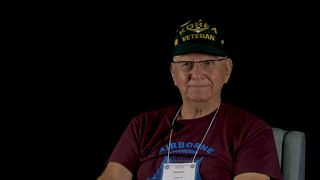4:57 | Canadian soldier Ralph McKay describes the attempts by the enemy in Korea to overrun his position. He still used his British single shot rifle, but many had traded with the Americans for better weapons. The men were ecstatic over the peace agreement, but they had to stay in country until their 14 month tour was up. At least no one was shooting at them.
Keywords : Ralph McKay Korea .303 British rifle Panmunjom USS General M. M. Patrick mortar

His father was a coal miner in Nova Scotia and it shortened his life, so Ralph McKay did not go into the mines, he joined the army as soon as he was eligible at seventeen. He was assigned to the Royal Canadian Regiment, the oldest unit in Canada, and then to jump school. His first jump was memorable.
He shipped out to Korea and, right away, he was disturbed by something he saw in the streets of Pusan. Ralph McKay knew then he was somewhere very different from his home in Canada. It was 1953, late in the war, but the shelling was nearly constant on the front line.
Ralph McKay was at Hill 355 on the front line in Korea. It was during the stalemate period and each side watched the other across the valley between them, occasionally firing artillery or mortars. One mortar shell killed the Canadian unit's cook, their first fatality. McKay was disturbed after he picked up his dead friend, but in those days, you dared not say anything about your feelings.